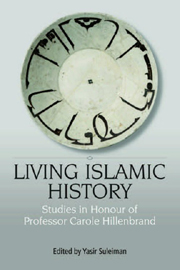Book contents
- Frontmatter
- Contents
- Acknowledgements
- Professor Carole Hillenbrand: List of Publications
- Preface
- 1 The Origin of Key Shi‘ite Thought Patterns in Islamic History
- 2 Additions to The New Islamic Dynasties
- 3 Al-Tha‘alibi's Adab al-muluk, a Local Mirror for Princes
- 4 Religious Identity, Dissimulation and Assimilation: the Ismaili Experience
- 5 Saladin's Pious Foundations in Damascus: Some New Hypotheses
- 6 The Coming of Islam to Bukhara
- 7 A Barmecide Feast: the Downfall of the Barmakids in Popular Imagination
- 8 The History of the Patriarchs of the Egyptian Church as a Source for the History of the Seljuks of Anatolia
- 9 Genealogy and Exemplary Rulership in the Tarikh-i Chingiz Khan
- 10 Vikings and Rus in Arabic Sources
- 11 Qashani and Rashid al-Din on the Seljuqs of Iran
- 12 Exile and Return: Diasporas of the Secular and Sacred Mind
- 13 Clerical Perceptions of Sufi Practices in Late Seventeenth-Century Persia, II: Al-Hurr al-‘Amili (d. 1693) and the Debate on the Permissibility of Ghina
- 14 On Sunni Sectarianism
- 15 The Violence of the Abbasid Revolution
- 16 Nationalist Poetry, Conflict and Meta-linguistic Discourse
- Bibliography
- List of Contributors
- Index
15 - The Violence of the Abbasid Revolution
Published online by Cambridge University Press: 12 September 2012
- Frontmatter
- Contents
- Acknowledgements
- Professor Carole Hillenbrand: List of Publications
- Preface
- 1 The Origin of Key Shi‘ite Thought Patterns in Islamic History
- 2 Additions to The New Islamic Dynasties
- 3 Al-Tha‘alibi's Adab al-muluk, a Local Mirror for Princes
- 4 Religious Identity, Dissimulation and Assimilation: the Ismaili Experience
- 5 Saladin's Pious Foundations in Damascus: Some New Hypotheses
- 6 The Coming of Islam to Bukhara
- 7 A Barmecide Feast: the Downfall of the Barmakids in Popular Imagination
- 8 The History of the Patriarchs of the Egyptian Church as a Source for the History of the Seljuks of Anatolia
- 9 Genealogy and Exemplary Rulership in the Tarikh-i Chingiz Khan
- 10 Vikings and Rus in Arabic Sources
- 11 Qashani and Rashid al-Din on the Seljuqs of Iran
- 12 Exile and Return: Diasporas of the Secular and Sacred Mind
- 13 Clerical Perceptions of Sufi Practices in Late Seventeenth-Century Persia, II: Al-Hurr al-‘Amili (d. 1693) and the Debate on the Permissibility of Ghina
- 14 On Sunni Sectarianism
- 15 The Violence of the Abbasid Revolution
- 16 Nationalist Poetry, Conflict and Meta-linguistic Discourse
- Bibliography
- List of Contributors
- Index
Summary
‘It was not to shed blood and act unjustly that we followed the Family of Muhammad‘’ – so proclaimed Sharik b. Shaykh when he rebelled against Abu Muslim in 133/750. Or at least that is what al-Tabari reports that he said, since here he follows the historiographic convention of ascribing motivation through the direct speech of the figure in question. Al-Ya‘qubi has a variant: ‘It was not to shed blood and act unjustly that we gave the oath of allegiance to the Family of the Prophet.’ Precisely what Sharik b. Shaykh actually said or thought, we shall never know; nor, for that matter, can we say much about his movement in Bukhara beyond that it apparently fizzled out quickly, despite what Narshakhi reports as some broad support. But whatever the precise depth and breadth of that support, we can be sure that others felt the same way. The blood-letting of the Abbasid Revolution had gone too far, and one set of tyrants had been replaced by another: in the eyes of Sharik and those like-minded, the principles for which the Hashimiyya had fought – just rule under a member of the Family of the Prophet, in accordance with God's Book – had been betrayed.
The two ideas – blood and tyranny – are neatly combined in two lines of poetry, which were reportedly inscribed on a sword that had killed innocents in the wake of that Revolution:
When the amir and his two retainers commit tyranny
and the earthly judge exceeds all limits in decreeing (asrafa fil-qada’)
Then woe, upon woe, upon woe
from the Heavenly judge upon the earthly one.
- Type
- Chapter
- Information
- Living Islamic HistoryStudies in Honour of Professor Carole Hillenbrand, pp. 226 - 251Publisher: Edinburgh University PressPrint publication year: 2010



